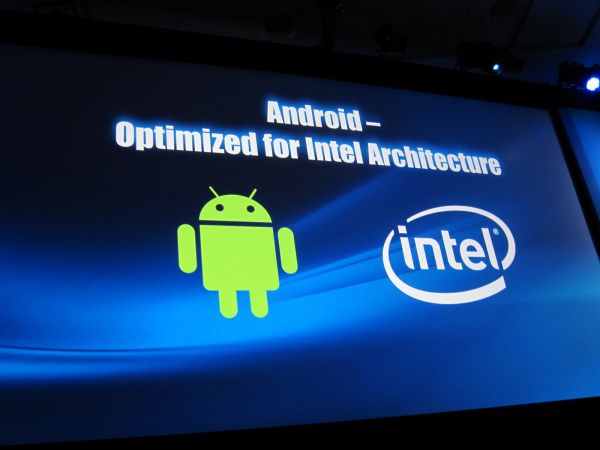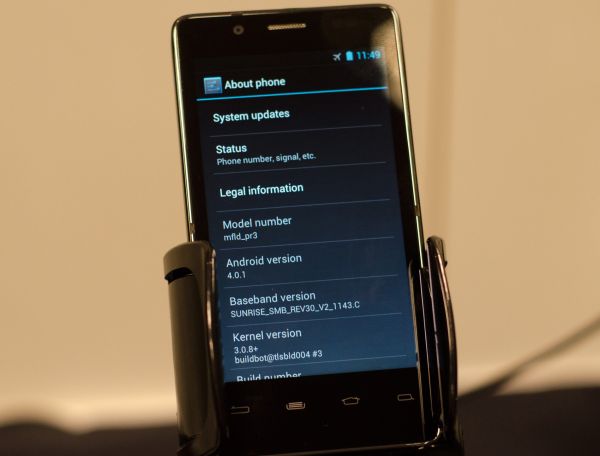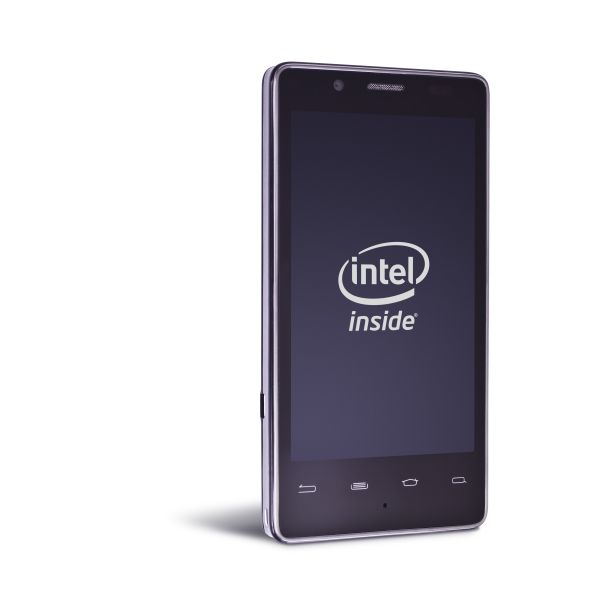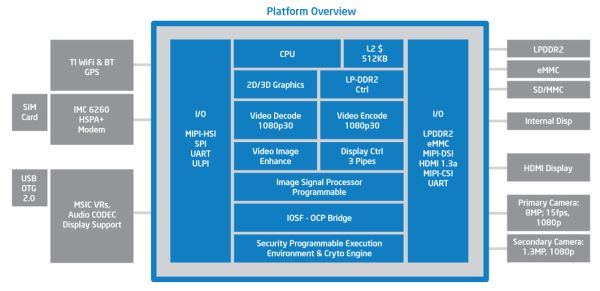Intel's Medfield & Atom Z2460 Arrive for Smartphones: It's Finally Here
by Anand Lal Shimpi on January 10, 2012 8:00 PM ESTWhat's Different This Time Around: Google & A Sweet Reference Platform
Intel has been talking about getting into smartphones for a couple of years now, but thus far it hasn't been able to secure a single design or partnership that that resulted in a product actually coming to market. This time around, things are different. The major change? Focus, and Google.
Intel originally had ambitions of enabling its own mobile OS with the help of Nokia (Moblin/MeeGo). Intel also wanted to support Android as well, however its attention was clearly more focused on the Moblin/MeeGo effort. Similar to the wake up call that pushed NVIDIA to focus exclusively on Android, Intel has now done the same.
At IDF last year Intel and Google announced a partnership and the intention to bring all future versions of Android, starting with Gingerbread, to x86. Since then Intel has ramped up the software engineering engine, going into the Android source code (Gingerbread, Honeycomb and now ICS) and fixing bugs. Intel's goal is to deliver the most stable version of Android as a result of its efforts. Intel is also submitting its changes upstream to the AOSP, which should help improve the Android experience even on ARM platforms.
Under the leadership of Mike Bell (formerly of Apple and Palm), Intel has also created an extremely polished Medfield reference design. This is the same design shown off at IDF last year (apparently there's an even thinner one floating around somewhere), but what separates it from other reference designs we've seen from SoC vendors is that the Medfield reference platform was designed to be a polished phone that could theoretically be rebranded and resold.
Intel knew the onus was on itself to prove that Medfield, Atom and even just x86 was power efficient enough to be delivered in a compelling form factor with competitive battery life. Paul Otellini gave Mike carte blanche access to any of Intel's resources. Instead of having to work with existing Intel groups, Mike was allowed to assemble his dream team of engineers. The team Mike built is what he felt he needed to not only bring Medfield to market, but also to build the a first class Atom based smartphone.
The result is this:
Internally it features Intel's own XMM 6260 HSPA+ modem. Intel claims LTE is on the way although there's no ETA on that.
WiFi in the reference design is provided by TI's 1283 controller. Intel's wireless team does not have a a WiFi solution that's low power enough to work in a smartphone, although after the recent restructuring the team has now been tasked with building an ultra low power solution that can.
The display is a somewhat unusual 1024 x 600 panel, with support for 1080p30 (and 1080i60) output via HDMI. The SoC specs are identical to what I've already discussed: 1.6GHz max CPU clock and a 400MHz GPU clock.
The reference platform is not only smartphone sized, but Intel has built its own qualification labs that mirror those of the carriers to ensure quality and convince its customers of the platform's legitimacy. In essence, Intel has built its own miniature smartphone design and test center.
The Medfield reference platform is available for use by any of Intel's customers, and indeed that's what's already happening. Lenovo's K800 is based on a modified version of Intel's reference platform, and I wouldn't be surprised if more aren't on the way.
All of this sounds a lot like Intel's efforts in the motherboard space over a decade ago where it started providing motherboard manufacturers with reference designs that they could modify if they desired. The effort helped significantly reduce time to market and allowed the motherboard makers to focus more on specializing on what they were good at.
The Medfield reference platform is designed to do the very same for smartphones. Intel wants to provide its partners with a well designed, stable smartphone platform. If they choose to use it, they can shave off a significant amount of development time and spend more of their time on software or simply bring a good reference phone to market in a quick fashion. I'm not entirely sure I've seen many players in the Android space that are actually all that great at software development, but Intel believes anything that shortens time to market will be appreciated.
I asked Intel if it has any plans to offer the reference platform unlocked, direct to customers. Unfortunately the answer at this point is still no. I suspect that Intel is more interested in building its customer base rather than circumventing it.
















164 Comments
View All Comments
Griswold - Thursday, January 12, 2012 - link
How is "too little too late" going to help Intel? By the time products with this trash flock to market, it'll be up against A15 and look like the thing from yesteryear it really is..iwod - Tuesday, January 10, 2012 - link
It was always only a matter of time before Intel get a x86 CPU with their superior manufacturing down to ARM SoC level.And since new science discovery is pushing Moores Law's Limit further and further away, intel has a much better fighting chance.
The problem is how much does an Intel SoC cost compare to a reference design ARM made SoC in TSMC?
Griswold - Thursday, January 12, 2012 - link
Come back in a year and ask again... thats when this hits the shelves.Computer Bottleneck - Tuesday, January 10, 2012 - link
Thank you for the article!Is there any chance we could see a teardown and analysis of the Intel Medfield reference design platform in the next 6 months?
I think it would be very interesting to compare Intel's progress in chip integration over the next few years. (ie, Compare Medfield reference platform to Silvermont reference platform to Airmont reference platform, etc)
jwcalla - Tuesday, January 10, 2012 - link
I just got an ulcer thinking about how Android fragmentation is going to be taken to a whole new level."There's already support for targeting both ARM and x86 architectures in the Android NDK so anything developed going forward should be ok so long as the developer is aware of x86."
heh
right
That's sunshine and lollipops right there.
It isn't enough to worry about 4,000 different CPUs and five active versions of the OS, but now we have to worry about two completely incompatible instruction sets too. All for the glory of producing apps that make no money on this platform. Suddenly iOS seems even more attractive.
hechacker1 - Wednesday, January 11, 2012 - link
It's only niche apps that require specific machine code that won't work. Otherwise the interpreted bytecode should just work.It's similar to when Apple moved from PPC to x86. You just had to recompile the program with the new toolchain and it would create a universal binary. Except here, it isn't even necessary to recompile the majority of the time.
If anything, with the introduction of Android 4.0, we will finally have a common base for phones, tablets, and the one or two smart TVs. Sure it will require an upgrade for most users stuck on older unsupported Android versions, but that will come with time.
nofumble62 - Wednesday, January 11, 2012 - link
the difference now is all about peripheral and IO design. The ARM advantage has shrinken to almost zero.tipoo - Wednesday, January 11, 2012 - link
Shrunken. Sorry.dealcorn - Wednesday, January 11, 2012 - link
ARM earned it's dominance of the mobile space with affordable, superior power efficiency. Now, Intel waltz's in with a 5 year old design for a space it used to know nothing about and it has superior power efficiency. Is there some reason to think this is in any way not a replay of the old Intel vs RISC story?It is hard to take ARM seriously when Intel's old design from a period when it was generally clueless is superior to what ARM markets today. However, we would not be here without ARM's historic contribution. Also, the market for garage door openers is not going away.
aury - Wednesday, January 11, 2012 - link
"superior power efficiency"how is this chip superior, itt uses more power than Samsungs old A9 cortex, and Samsung's implementation isn't even the the most power efficient, let alone that the A9 is an old chip to begin with